Obtaining and maintaining high corn quality silage requires good management in the areas of forage management harvest, storage and feedout. For this article’s discussion, it is assumed that proper genetics have been selected to provide maximum levels of milk per acre of corn silage. Harvest The most important things to remember when harvesting corn silage are whole-plant moisture level, theoretical length of chop and kernel processing. The desired level of whole-plant moisture will depend on whether the silage is stored in upright or horizontal silos. For bunkers and drive-over piles, I like to see whole-plant moisture at 66 to 68 percent and for vertical storage structures, 63 to 66 percent.
The theoretical length of chop (TLC) should be 3/4 to 1 inch for kernel processed corn silage and 1/2 to 5/8 for unprocessed corn silage. Processed corn silage allows for less sorting of corn cob pucks by the cows, which increases the amount of effective fiber fed. Most of the corn silage that is cut at 3/4-inch and properly processed will end up on the middle screen of the Penn State Shaker box. When included in the TMR, this makes the corn silage more desirable for maximum milk production and cow health.
The spacing on the kernel processors should be set at the thickness of a dime (1 millimeter). Processed corn silage allows better digestion of the starch in the corn kernel, which decreases the dependence on corn in the TMR, thus increasing the level of forage in the TMR from corn silage.
Storage
High-quality corn silage needs to be harvested rapidly, packed well and sealed tightly with a plastic cover as soon as the silage pile, bunker or upright silo is filled. For drive-over piles we like to see no more than a 3-in-12 pitch on the sides and ends so that we can get maximum packing and to allow the plastic cover and tires to remain in place. It is best to design the width of the piles and bunkers according to herd size so that we can remove 6 and 12 inches per day off the face during summer and winter months, respectively. We want to do this to minimize heating and aerobic deterioration of the silage.
Silage should be packed to a minimum of 16 pounds of dry matter per cubic foot, and more is better. Research has shown less dry matter loss or shrink in the silage pile as the packing density is increased. Silage can be well-packed with tractors that have narrow tires and are loaded with lots of weight so that the maximum pounds per square inch can be obtained on each tire of the tractor. The number of packing tractors needed to pack silage in bunkers and drive-over piles is directly related to the number of tons of silage delivered to the pile per hour. The formula to determine the minimum amount of tractor weight needed to pack the silage to the desired level is as follows: 800 times the tons of silage delivered per hour. For example: 200 tons per hour will require 160,000 pounds of packing tractor. This weight is close to four four-wheeled tractors that are heavily loaded with extra weight.
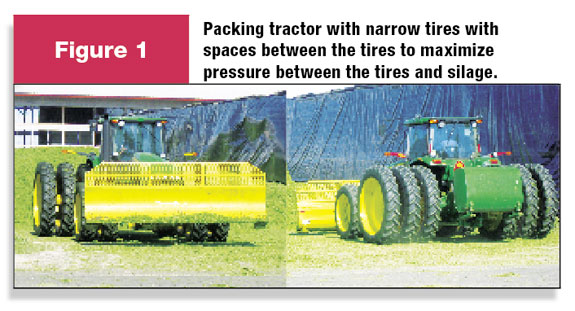
The other important part of obtaining maximum density of the silage is packing the silage in layers that are 4 to 6 inches. A couple of tractors with blades need to push the silage in one directionm with a couple of packing tractors packing in a direction perpendicular to the bladed tractors.
Packers need to pack each layer of silage until there are no ridges of silage showing. This requires a very coordinated effort by all of the tractor drivers to maximize their time on the pile or bunker and to be safe. Figure 1 shows a well-designed packing tractor with a blade.
After the silage pile is packed, it needs to be covered as soon as possible with plastic weighted with a solid layer of tires or half tires. Many dairies use a second layer of clear plastic that obstructs the flow of air into the silage 100 times greater than regular plastic.
However, the clear plastic will deteriorate in sunlight and needs to be covered with the regular plastic used on silage piles. There are companies that make a single sheet of the regular plastic that covers the entire pile.
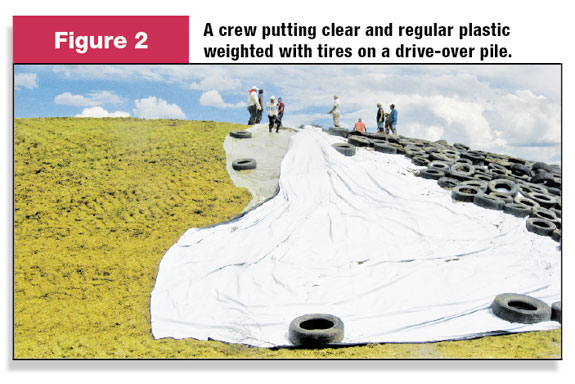
Figure 2 shows how a drive-over pile is covered with the clear and regular plastic weighted with tires. Covering the silage with these plastics keeps the spoilage to a minimum.
Most of the time the clear plastic and regular plastic combo stops the spoilage of corn silage and haylage that we often see at the top of the silage pile. This decreases the need to pitch off spoiled silage and increases worker safety.
Feedout
Poor silage face management can lead to poor-quality silage and loss of silage due to heating and spoilage. A well-managed face is vertical and smooth with no loose silage remaining on the floor when feeding is completed for the day. This is why it is important to size the bunker or pile according to the herd size.
However, piles require more space than bunker silos due to the sloping sides and often one large pile of corn silage is put up on large dairies.
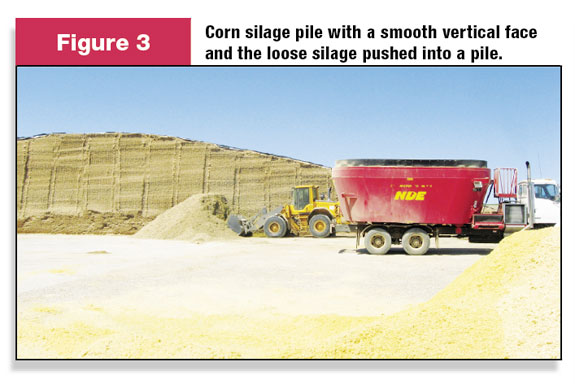
This often requires splitting the face into two or three sections so that we can remove a minimum of 6 to 12 inches off the face during winter and summer, respectively.
Finally, we want the silage that has been faced to be pushed into a pile. Figure 3 shows corn silage that has been faced and pushed into a pile. The pile of loose silage in the middle of the drive-over pile is more consistent in moisture and nutrient levels.
Keeping the face of silage piles smooth keeps it from heating and spoiling. The heating and spoilage is caused by wild yeast, aerobic bacteria and molds. It is also important to clean up all of the loose silage that is faced so that it does not heat and spoil.
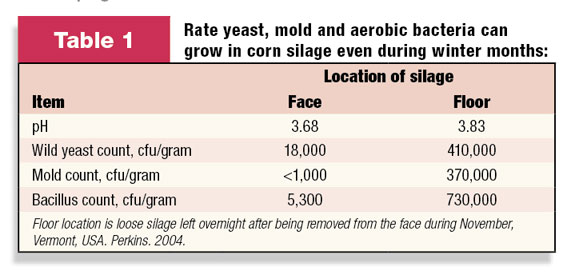
Table 1 shows how rapidly yeast, mold and aerobic bacteria can grow in corn silage even during winter months:
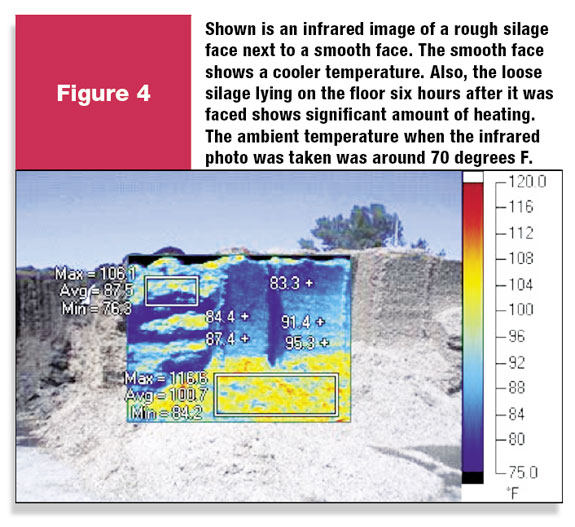
Also, the loose silage lying on the floor six hours after it was faced shows significant amount of heating. The ambient temperature when the infrared photo was taken was around 70째F.
In summary, high-quality silage starts with planting and cultivating seed corn that will maximize milk per acre. The corn crop needs to be harvested at the right whole-plant moisture, chopped at the correct length, packed tightly in the bunker or pile and well-covered with weighted plastic. There should be enough silage inventory to allow the new crop to ferment several months before it is fed.
Keep the silage face vertical and smooth with no loose silage remaining on the floor after feeding is complete. PD
References available upon request.





